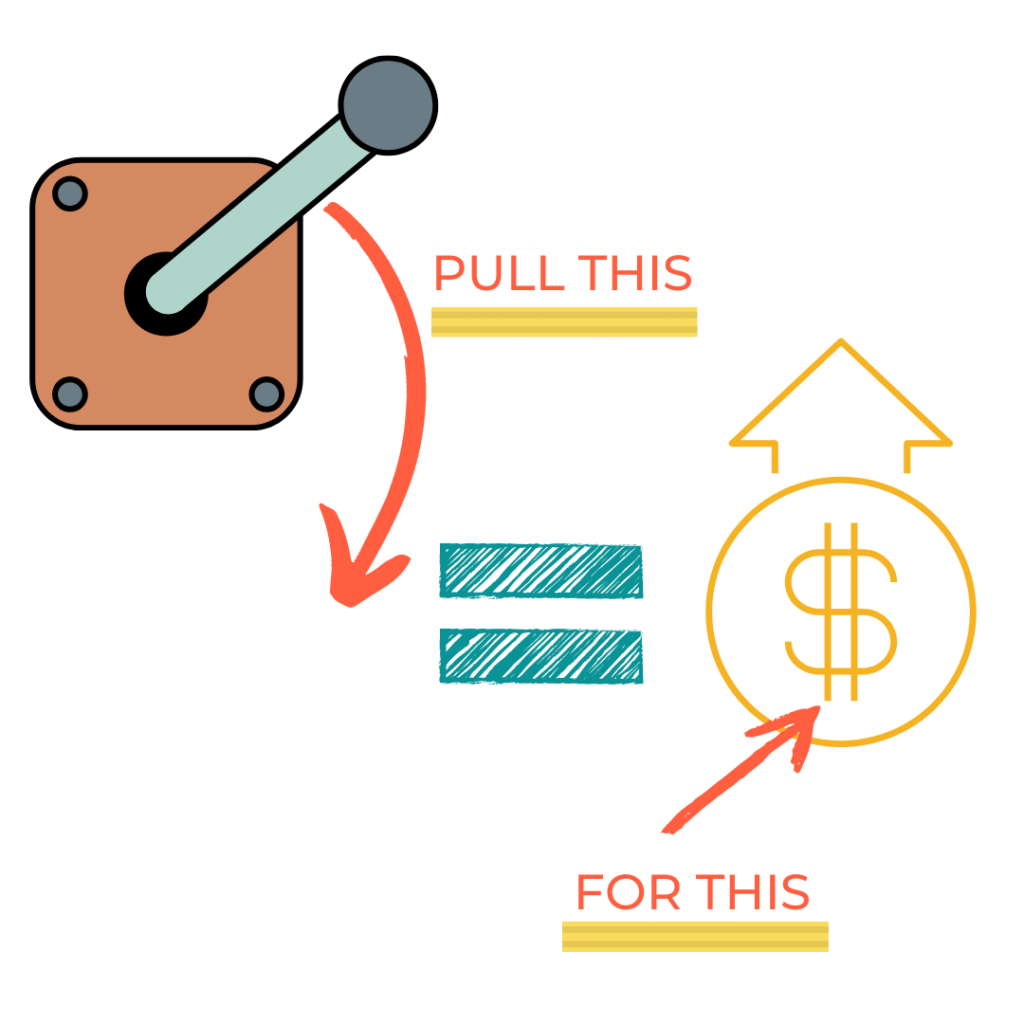Increase your luck surface area
It’s easy to look at successful entrepreneurs and business owners who seem to have achieved overnight success, and assume that they got lucky.
The assumption about luck is that it seems to have very little to do with your own efforts. This can make you feel powerless to shape your own success.
In truth, there are many ways to increase your luck surface area.
Sahil Bloom, early-stage investor and business influencer with over 500k followers, explains it like this:
'If you want to get lucky, start by increasing your luck surface area. It’s hard to get lucky watching TV at home.
It’s (relatively) easy to get lucky when you’re engaging with people, interacting, and learning—physically or digitally.
Put yourself in a position to get lucky.'Sahil Bloom Tweet
Do things that don't scale
Finding ways to increase your luck surface area brings the power to succeed back to you. You create your own luck.
A recent newsletter by an ex-colleague of mine, Karl Gostner, now an executive coach, (previously COO at Primedia Broadcasting) linked me to an old, but highly relevant article by Paul Graham, co-founder of Y Combinator.
Y Combinator created a new model for funding early-stage startups. Twice a year they invest $500,000 per company in a large number of startups.
With their deep experience in helping startups succeed, Graham shares learnings that help to increase your luck surface area. And he speaks about the importance of doing things that won’t scale.
Do-whatever-needs-to-be-done
Many online businesses start with the expectation that online success is just a ‘plug and play’ model – and that their efforts need to focus on scalability i.e. exponential growth without additional resources.
And yes, a scalable business is the dream – Real growth, without additional effort. But Graham just suggests that this isn’t the first step for a new business.
Even today’s giants, started pre-scale, hands on, do-whatever-needs-to-be-done. In other words, they started by increasing their luck surface area.
Gostner’s newsletter sums it up:
He notes that any business in its early stages is fragile and clunky. The first 50 Apple computers were built by hand. The founders of Pebble did the same thing, assembling the first few hundred watches themselves, by hand. When Brian Chesky and Joe Gebbia were building AirBnB they took photographs of the apartments themselves. Lisa Price founded Carol’s Daughter, she made her products in her kitchen and sold them at markets. Allen Ambor would chase after customers in the rain persuading them to come into his first Spur Steak Ranch. The fragility can be intimidating. Bill Gates went back to Harvard after starting Microsoft. He only stayed for one semester, but it says a lot about the doubts he was having about Microsoft.
Karl Gostner Tweet
Let's look at how you can increase your luck surface area in your new business
Credibility and trust are built over time. See our Relationships = Results playbook for more about building trust.
Decide when and how you are going to show up, and then stick to it.
Consistency also allows for measurability.
Measurability allows for improvements.
Example: You decide to build your email list (a vital tool for business growth) by inviting social media audiences to sign up for a free lead magnet in exchange for their email address.
Develop a consistent email comms strategy to build the relationship from there. If your content is relevant and shows up consistently, you will build trust and credibility over time. Consistent newsletters also build authority.
From here you can measure open rates and click through rates, which allows you to learn what works for your audience, and adjust accordingly.
Chances are your clients won’t just find you. You need to do whatever it takes to build your client base.
Many solopreneurs with really fantastic offers fail to make it, because they hide behind making everything perfect, instead of reaching out to find clients.
Yes, it’s can feel scary putting yourself out there!
The more clear and practical your client acquisition plan is, the easier it will be to action. Note: Don’t drown in planning as an avoidance mechanism!
Jump on our next ‘Lists, Launches & Leverage’ Masterclass to get your head around acquisition without agony.
Put measurable plans in place with targets to celebrate when you achieve milestones.
Always be Measuring
From Paul Graham: We encourage every startup to measure their progress by weekly growth rate. If you have 100 users, you need to get 10 more next week to grow 10% a week. And while 110 may not seem much better than 100, if you keep growing at 10% a week you’ll be surprised how big the numbers get. After a year you’ll have 14,000 users, and after 2 years you’ll have 2 million.
We’ve all grown resistant to the icy cold corporate and their bigger-than-me form of engagement.
Don’t be that person. Be a human first.
Once a client signs up with you, make every effort to delight them.
To make this work consistently, brainstorm ways that will bring onboarding delight (without heavy time or cost investment that will make it unmanageable).
Then see which areas you can automate and which areas you will show up in person.
The more that you build direct engagement with your first clients, the more you will be able to serve them meaningfully.
Sam Parr, founder of The Hustle (subsequently bought by Hubspot for gazillions) has over 120,000 followers on twitter, and still engages personally with his followers in the comments.
At RubyMBA, we jump on one-on-one calls with each of our group coaching clients to better understand what they want, where their pain and frustrations lie, and just to get to know them better. This has been hugely valuable in shaping our offerings.
In the beginning, you’ll be stretched across many aspects of your business.
It makes sense to focus on a smaller, more targeted ideal client while you build up.
Here’s a simple example that I used in my radio days, when explaining to clients that it is more effective to concentrate their ad spend on a smaller audience, rather than spread their messaging too thin, in an effort to reach more people.
‘Imagine you are a boerewors roll vendor at a stadium. Would you sell more rolls by walking around the entire stadium once, reaching everyone once, shouting out your wares, or by walking up and down one section of the stands, reaching less people, repeatedly?
Very few of us decide to buy on the first round. We may be distracted, or we may not be hungry yet. We may think that something better is coming along, and a thousand other reasons.
The vendor that passes us just once, is unlikely to get our order. The vendor that passes by 3 or 4 times will finally catch us at our ‘ready-to-eat’ point.
At the start of your business, as much as it may seem counterintuitive, it’s best to niche down. The more targeted your core market is, the more relevant you can be in your messaging. You can be the specialist for that particular subset market.
Watch our Master Your Messaging series (videos 3 – 5 to better understand this niching.)
If you’re struggling to niche down in the beginning, Graham suggests working closely with a single client to really understand what they need.
The more you adjust your offering to really serve that single client, the more you will become deeply relevant to a subset that looks similar to this client.
Radio presenters are often told to imagine a single listener, a subset of a subset of the total audience, and to speak personally to them.
At RubyMBA we work closely with two of our Group Coaching clients to fine tune our offering.
They closely represent our ‘ideal client’ and we so appreciate their feedback.
This has helped us to give real value, rather than offer broad strokes that can miss the mark.
As we adjust content to be more relevant to their needs, we find that other clients tell us how spot on our support is.
Jeff Walker, the grandfather on online launches advises new businesses to start with a personal, ‘information gathering’ launch, before moving on to a medium launch, and finally the Joint Venture (JV) Launch, when all the bugs have been ironed out.
And rightly so. There is so much that you may not know about your ideal client in the beginning. Your messaging and offer may need tweaking until you find the sweet spot, between who they are, what they actually need, and how your product serves that need.
Starting with a big launch puts you at a greater hit or miss risk. You will be spending more and reaching more people – to possibly miss the mark with them.
Start with a small launch, really understand what works and what doesn’t, and then expand from there.
Every client that we work with has been grateful for the teething launch insights, that allow then to build a stronger launch muscle before going big.
Where can you increase your luck surface area in your business? We’d love to hear your thoughts.

